Concept of Spaceborne Ocean Microwave Dual-Function Integrated Sensor for Wind and Wave Measurement
Abstract
:1. Introduction
1.1. Background and Challenge
1.2. Current Research
1.3. Work and Arrangement of This Paper
2. Overview of the Dual-Function Integrated Sensor
2.1. Scientific Requirements and Operating of the Instrument
- Beam steer is flexible to complete conical scanning.
- The SNR of the echoes is high enough or informative enough to achieve high-precision inversion.
2.2. Observation Modes of the Concept
- Local Mode: This mode is utilized to retrieve the wind and wave fields at specific locations, such as a harbor or shallow banks. It provides high-resolution data for targeted areas.
- Regional Mode: This mode obtains wind and wave information for specific regions, such as coastlines. It offers a good balance between resolution and coverage.
- Global Mode1: This mode acquires high-resolution global wind and wave information, providing detailed insights into ocean dynamics across the planet.
- Global Mode2: This mode describes the global distribution of ocean winds and waves at a scale comparable to global climate models. Although it offers superior temporal resolution compared to Global Mode 1, the spatial resolution is coarser.
2.3. Potentialities of the Proposed Concept
- High-precision, multi-resolution, and large-coverage ocean wind field:
- Complementarity of inversion results: The two functions provide complementary and corrective wind field information, ultimately leading to the retrieval of large-coverage, high-precision, and multi-scale wind fields.
- Enhanced inversion accuracy: The scatterometer function provides the necessary wind direction information when the SAR function retrieves high-resolution wind fields. This information is strictly synchronized with the SAR function in both time and space, offering a significant improvement over traditional external auxiliary data.
- Refined low-resolution wind fields: The low-resolution wind fields retrieved by the scatterometer function can be further refined by incorporating the high-resolution information obtained from the SAR function.
- High-precision, multi-resolution, and large-coverage ocean wave spectrum.
- Providing prior information: When theoretical algorithms are employed to retrieve wave direction spectrums from SAR images, the scatterometer function can provide essential prior information [38].
- Compensating for high wavenumber cutoff: the relationship between radar cross-section and wave parameters has been established in reference [39], which proved the ability of scatterometer to extract wave parameters. The scatterometer function can compensate for the loss of information caused by the high wavenumber cutoff that affects the SAR function [39].
- Evaluating and improving inversion accuracy: Comparing and verifying the wave parameters obtained from both functions allows for evaluation and improvement of the overall inversion accuracy.
3. Constraints of System Parameters
3.1. Frequency
3.2. Antenna Size
3.2.1. SAR Function
- Minimum antenna area: To avoid aliasing of echoes in both azimuth and range, a minimum antenna area is required [42].
- SNR: The larger the antenna size, the higher SNR of the echoes [43].
- Azimuth resolution: The azimuth resolution is inversely proportional to the antenna size. A smaller antenna size translates to finer details captured in the azimuth direction [43].
- Swath: As shown in the satellite observation geometry model in Figure 5, the swath of the SAR function is determined by the range beamwidth and incidence angle at a specific orbit altitude. A smaller range antenna size results in a wider range beam-width, leading to a wider swath. This relationship can be expressed as:where is the swath width, is the radius of the earth, and are the incidence angle of the far and near end of the beam, respectively, denotes the range beamwidth, and represent the elevation angle of the far and near end of the beam, respectively, , is the wavelength of electromagnetic wave, denotes the antenna size in range direction, and is the orbit height.
3.2.2. Scatterometer Function
- Spatial resolution: The spatial resolution is a key factor influencing the antenna size. The larger the antenna size, the smaller the beam footprint, resulting in higher spatial resolution [12].
- Coverage of the sea surface: Excessive increase of antenna size, that is, excessive reduction of footprint size, will affect the continuity of the coverage, and thus affect the inversion accuracy. Although increasing the PRF can ameliorate this problem, it also means a significant increase in power consumption, as well as increased sensitivity requirements for beam switching operations [42].
3.3. Incidence Angle
3.4. Time Sequence
3.4.1. Constraints of the Working Principles
3.4.2. Constraints of Transmitting Time
3.4.3. Constraints of Receiving Window
3.4.4. Constraints of Nadir Echo
3.4.5. Jointly Design Method of the PRFs
4. Discussion: Selection of the System Parameters
4.1. Frequency
4.2. Antenna Size
4.3. Incidence Angle
4.4. Time Sequence
5. Conclusions
Author Contributions
Funding
Data Availability Statement
Conflicts of Interest
References
- Ho, C.R.; Liu, A.K. Preface: Remote Sensing Applications in Ocean Observation. Remote Sens. 2023, 15, 415. [Google Scholar] [CrossRef]
- Li, X.F.; Zhang, B.; Yang, X. Remote Sensing of Sea-Surface Wind and Wave from Spaceborne Synthetic Aperture Radar. J. Radar 2020, 9, 425–443. [Google Scholar]
- Amani, M.; Moghimi, A.; Mirmazloumi, S.M.; Ranjgar, B.; Ghorbanian, A.; Ojaghi, S.; Ebrahimy, H.; Naboureh, A.; Nazari, M.E.; Mahdavi, S.; et al. Ocean remote sensing techniques and applications: A review. Water 2022, 14, 3400. [Google Scholar] [CrossRef]
- Ahmad, H. Applications of Remote Sensing in Oceanographic Research. Int. J. Oceanogr. Aquac. 2019, 3, 000159. [Google Scholar] [CrossRef]
- Spencer, M.W.; Wu, C.; Long, D.G. Improved Resolution Backscatter Measurements with the SeaWinds Pencil-beam Scatterometer. IEEE Trans. Geosci. Remote Sens. 2000, 38, 89–104. [Google Scholar] [CrossRef]
- Breivik, Ø.; Mogensen, K.; Bidlot, J.R.; Balmaseda, M.A.; Janssen, P.A. Surface Wave Effects in the NEMO Ocean Model: Forced and Coupled Experiments. J. Geophys. Res. Oceans 2015, 120, 2973–2992. [Google Scholar] [CrossRef]
- Schroeder, L.C.; Boggs, D.H.; Dome, G.; Halberstam, I.M.; Jones, W.L.; Pierson, W.J.; Wentz, F.J. The Relationship between Wind Vector and Normalized Radar Cross Section Used to Derive SEASAT-A Satellite Scatterometer Winds. J. Geophys. Res. Oceans 1982, 87, 3318–3336. [Google Scholar] [CrossRef]
- Wang, J. A Study of HY-2A Satellite Microwave Scatterometer Sea-Surface High-Wind Field Retrieval Model; Guangzhou University: Guangzhou, China, 2017; p. 1314. [Google Scholar]
- Liu, W.K.; Budillon, A.; Pascazio, V.; Schirinzi, G.; Xing, M.D. Performance Improvement for SAR Tomography based on Local Plane Model. IEEE J. Sel. Topics Appl. Earth Observ. Remote Sens. 2022, 15, 2298–2310. [Google Scholar] [CrossRef]
- Hersbach, H.; Stoffelen, A.; de Haan, S. An Improved C-band Scatterometer Ocean Geophysical Model Function: CMOD5. Geophys. Res. Oceans 2007, 112, C03006. [Google Scholar] [CrossRef]
- Wu, C.; Liu, Y.; Kellogg, K.H.; Pak, K.S.; Glenister, R.L. Design and Calibration of the SeaWinds Scatterometer. IEEE Trans. Aerosp. Electron. Syst. 2003, 39, 94–109. [Google Scholar]
- Grantham, W.; Bracalente, E.; Jones, W.; Johnson, J. The SEASAT-A satellite Scatterometer. IEEE J. Ocean. Eng. 1977, 2, 200–206. [Google Scholar] [CrossRef]
- Bao, Q.L.; Dong, X.L.; Zhu, D.; Xu, X.O. Ocean Surface Current Measurement Using Rotating Pencil-Beam Scatterometer. Acta Electron. Sin. 2015, 43, 1200–1204. [Google Scholar] [CrossRef]
- Wang, K.; Hong, J.; Zhang, W.; Zhang, Y.; Hui, Y.; Ming, F. Method of SAR Retrieving Ocean Surface Wind in Near Shore. J. Electron. Inf. Technol. 2013, 35, 1800–1805. [Google Scholar] [CrossRef]
- Liu, W.K.; Sun, G.-C.; Xing, M.D.; Pascazio, V.; Chen, Q.; Bao, Z. 2-D Beam Steering Method for Squinted High-Orbit SAR Imaging. IEEE Trans. Geosci. Remote Sens. 2021, 59, 4827–4840. [Google Scholar] [CrossRef]
- He, Y.; Shen, H.; Perrie, W. Remote Sensing of Ocean Waves by Polarimetric SAR. J. Atmos. Ocean. Technol. 2006, 23, 1768–1773. [Google Scholar] [CrossRef]
- Krieger, G.; Younis, M.; Huber, S.; Bordoni, F.; Patyuchenko, A.; Kim, J.; Laskowski, P.; Villano, M.; Rommel, T.; Lopez-Dekker, P.; et al. Digital Beamforming and MIMO SAR: Review and New Concepts. In Proceedings of the EUSAR 2012, Nuremberg, Germany, 23–26 April 2012; pp. 11–14. [Google Scholar]
- Gao, Y.; Wang, Y.; Wang, W. A New Approach for Ocean Surface Wind Speed Retrieval Using Sentinel-1 Dual-Polarized Imagery. Remote Sens. 2023, 15, 4267. [Google Scholar] [CrossRef]
- Hamze-Ziabari, S.M.; Foroughan, M.; Lemmin, U.; Barry, D.A. Monitoring Mesoscale to Submesoscale Processes in Large Lakes with Sentinel-1 SAR Imagery: The Case of Lake Geneva. Remote Sens. 2022, 14, 4967. [Google Scholar] [CrossRef]
- Klemas, V. Remote Sensing Techniques for Studying Coastal Ecosystems: An Overview. J. Coast. Res. 2011, 27, 2–17. [Google Scholar]
- Frison, P.L.; Mougin, E. Use of ERS-1 Wind Scatterometer Data Over Land Surfaces. IEEE Trans. Geosci. Remote Sens. 1996, 34, 550–560. [Google Scholar] [CrossRef]
- Stoffelen, A.; Anderson, D.L.T. Wind Retrieval and ERS-1 Scatterometer Radar Backscatter Measurements. Adv. Space Res. 1993, 13, 53–60. [Google Scholar] [CrossRef]
- Liu, W.K.; Sun, G.-C.; Xia, X.G.; Xing, M.D.; Fu, J.X.; Bao, Z. Focusing Challenges of Ships with Oscillatory Motions and Long Coherent Processing Interval. IEEE Trans. Geosci. Remote Sens. 2020, 59, 6562–6572. [Google Scholar] [CrossRef]
- Jiang, X.; Lin, M.; Liu, J.; Zhang, Y.; Xie, X.; Peng, H.; Zhou, W. The HY-2 Satellite and Its Preliminary Assessment. Int. J. Digit. Earth 2012, 5, 266–281. [Google Scholar] [CrossRef]
- Zhang, D.; Zhang, Y.; Hu, T.; Xie, B.; Xu, J. A Comparison of HY-2 and Quik-SCAT Vector Wind Products for Tropical Cyclone Track and Intensity Development Monitoring. IEEE Geosci. Remote Sens. Lett. 2014, 11, 1365–1369. [Google Scholar] [CrossRef]
- Hauser, D.; Soussi, E.; Thouvenot, E.; Rey, L. SWIMSAT: A Real-Aperture Radar to Measure Directional Spectra of Ocean Waves from Space-Main Characteristics and Performance Simulation. J. Atmos. Ocean. Technol. 2001, 18, 421–437. [Google Scholar] [CrossRef]
- Alpers, W.R.; Ross, D.B.; Rufenach, C.L. On the Detectability of Ocean Surface Waves by Real and Synthetic Aperture Radar. J. Geophys. Res. Oceans 1981, 86, 6481–6498. [Google Scholar] [CrossRef]
- Zhu, D.; Dong, X.; Yun, R.; Xu, X. Recent Advances in Developing the CFOSAT Scatterometer. In Proceedings of the IGARSS 2016, Beijing, China, 10–15 July 2016; pp. 5801–5803. [Google Scholar]
- Aouf, L.; Hauser, D.; Tison, C.; Mouche, A. Perspectives for Directional Spectra Assimilation: Results from A Study based on Joint Assimilation of CFOSAT Synthetic Wave Spectra and Observed SAR Spectra from Sentinel-1A. In Proceedings of the IGARSS 2016, Beijing, China, 10–15 July 2016; pp. 5820–5822. [Google Scholar]
- López-Dekker, P.; Rott, H.; Prats-Iraola, P.; Chapron, B.; Scipal, K.; De Witte, E. Harmony: An Earth explorer 10 mission candidate to observe land, ice, and ocean surface dynamics. In Proceedings of the IGARSS 2019 Symposium, Yokohama, Japan, 28 July–2 August 2019; pp. 8381–8384. [Google Scholar]
- Boccia, V.; De Witte, E.; Roselló, J.; Tossaint, M.; Donlon, C.J.; Scipal, K.; Bibby, D. StereoSAR: A multi-static SAR mission concept to enhance Sentinel-1 capabilities for measuring ocean dynamics. Sens. Syst. Next-Gener. Satell. 2017, 10423, 78–97. [Google Scholar]
- Lopez-Dekker, P.; Chapron, B.; Johnsen, H. Observations of Sea Surface Winds and Sea Surface Deformation with the Harmony Mission. In Proceedings of the EUSAR 2021, Online, 29 March–1 April 2021; pp. 1–4. [Google Scholar]
- Zhang, G.; Zhao, Y. Phased Array Radar Technology; Publishing House of Electronics Industry: Beijing, China, 2006; pp. 1–10. [Google Scholar]
- Qian, H.J.; Zhou, J.; Yang, B.; Luo, X. A 4-Element Digital Modulated Polar Phased-Array Transmitter with Phase Modulation Phase-Shifting. IEEE J. Solid-State Circuits 2021, 56, 3331–3347. [Google Scholar] [CrossRef]
- Dogan, D.; Gultepe, G. A Beamforming Method Enabling Easy Pack-Aging of Scalable Architecture Phased Arrays. In Proceedings of the PAST 2016, Waltham, MA, USA, 18–21 October 2016. [Google Scholar]
- Hauser, D.; Tourain, C.; Hermozo, L.; Alraddawi, D.; Aouf, L.; Chapron, B.; Tran, N. New Observations from the SWIM Radar On-Board CFOSAT: Instrument Validation and Ocean Wave Measurement Assessment. IEEE Trans. Geosci. Remote Sens. 2020, 59, 5–26. [Google Scholar] [CrossRef]
- Wang, T.; Li, X.; Zhang, G.; Lin, M.; Deng, M.; Cui, H.; Yuan, X. Large-scale orthorectification of GF-3 SAR images without ground control points for China’s land area. IEEE Trans. Geosci. Remote Sens. 2022, 60, 1–17. [Google Scholar] [CrossRef]
- Wan, Y.; Liu, Y. Research on Wind Field Joint Inversion Method Based on Microwave Multi-Load Complementary Advantages. J. Ocean. Technol. 2022, 41, 58–65. [Google Scholar]
- Wan, Y.; Zhang, X.; Fan, C.; Qu, R.; Ma, E. A Joint Method for Wave and Wind Field Parameter Inversion Combining SAR with Wave Spectrometer Data. Remote Sens. 2022, 14, 3601. [Google Scholar] [CrossRef]
- Wang, J. The Research of Retrieving Wave Information from GF-3 SAR Wave Mode Images; Zhejiang Ocean University: Zhoushan, China, 2019. [Google Scholar]
- Chen, Q.; Liu, W.K.; Sun, G.-C.; Chen, X.X.; Han, L.; Xing, M.D. A Fast Cartesian Back-Projection Algorithm Based on Ground Surface Grid for GEO SAR Focusing. IEEE Trans. Geosci. Remote Sens. 2022, 60, 1–14. [Google Scholar] [CrossRef]
- Zhang, Q.J. Satellite Polarization Microwave Remote Sensing Technology; Chinese Astronautics Industry in Beijing: Beijing, China, 2015; pp. 46–54. [Google Scholar]
- Xing, M.D.; Sun, G.-C.; Wang, T. Synthetic Aperture Radar Imaging Technology; Publish House of Electronics Industry: Beijing, China, 2024; pp. 99–100. [Google Scholar]
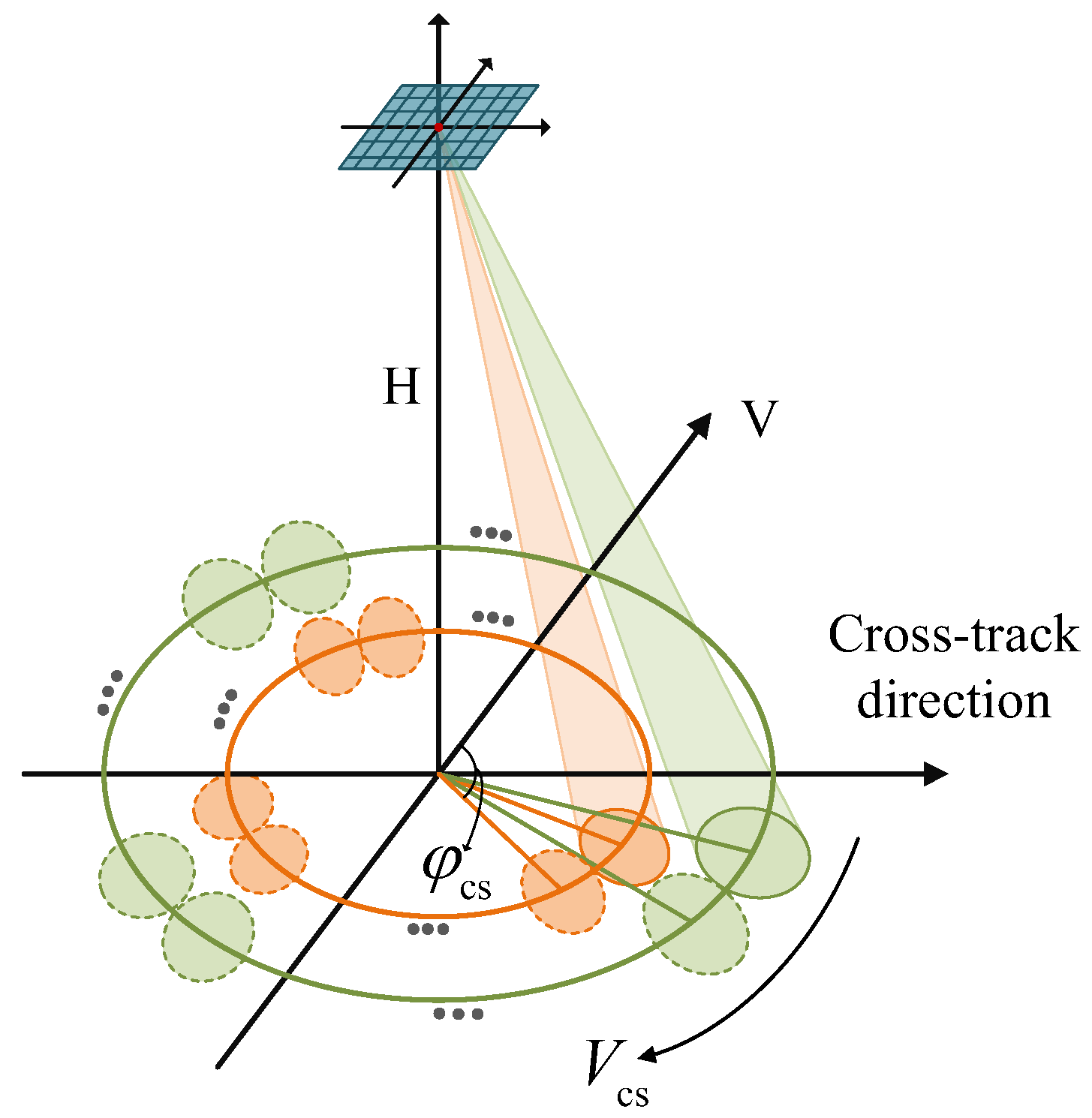

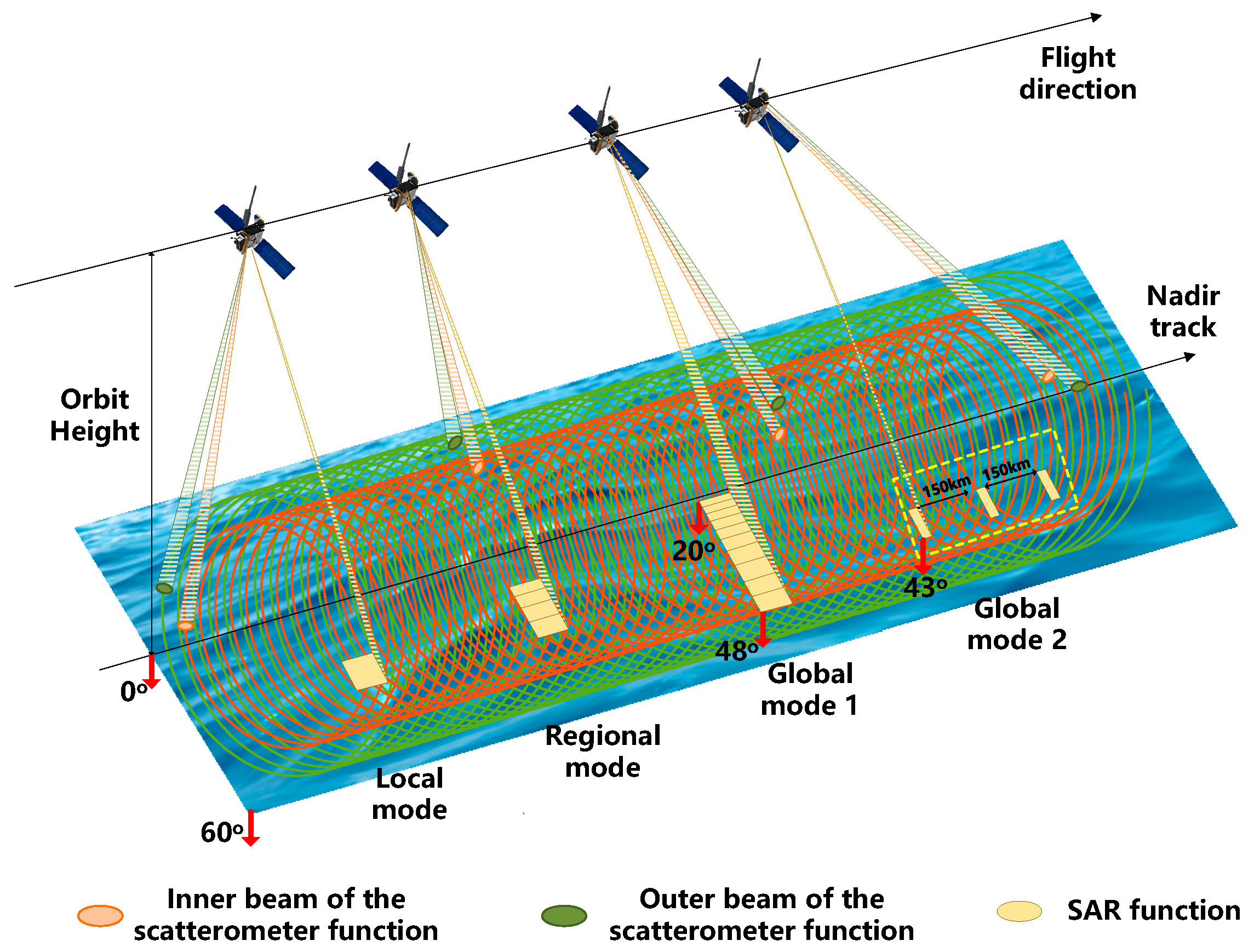



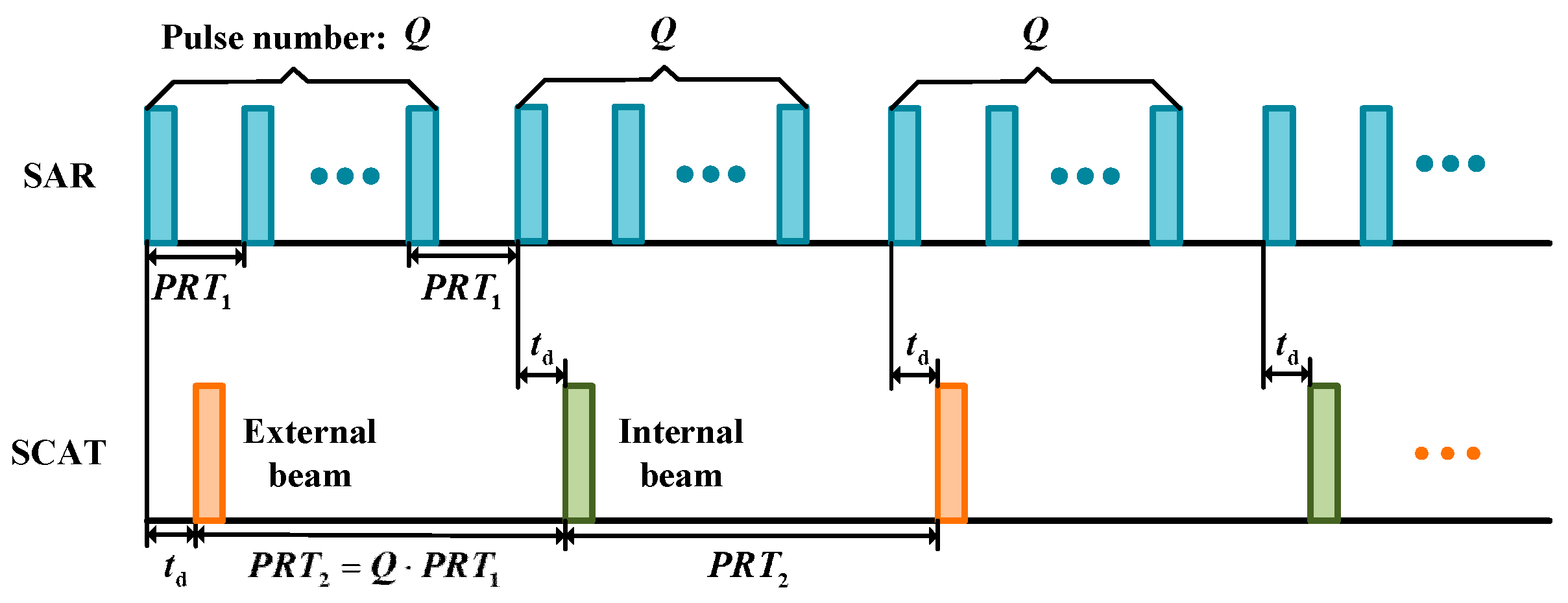


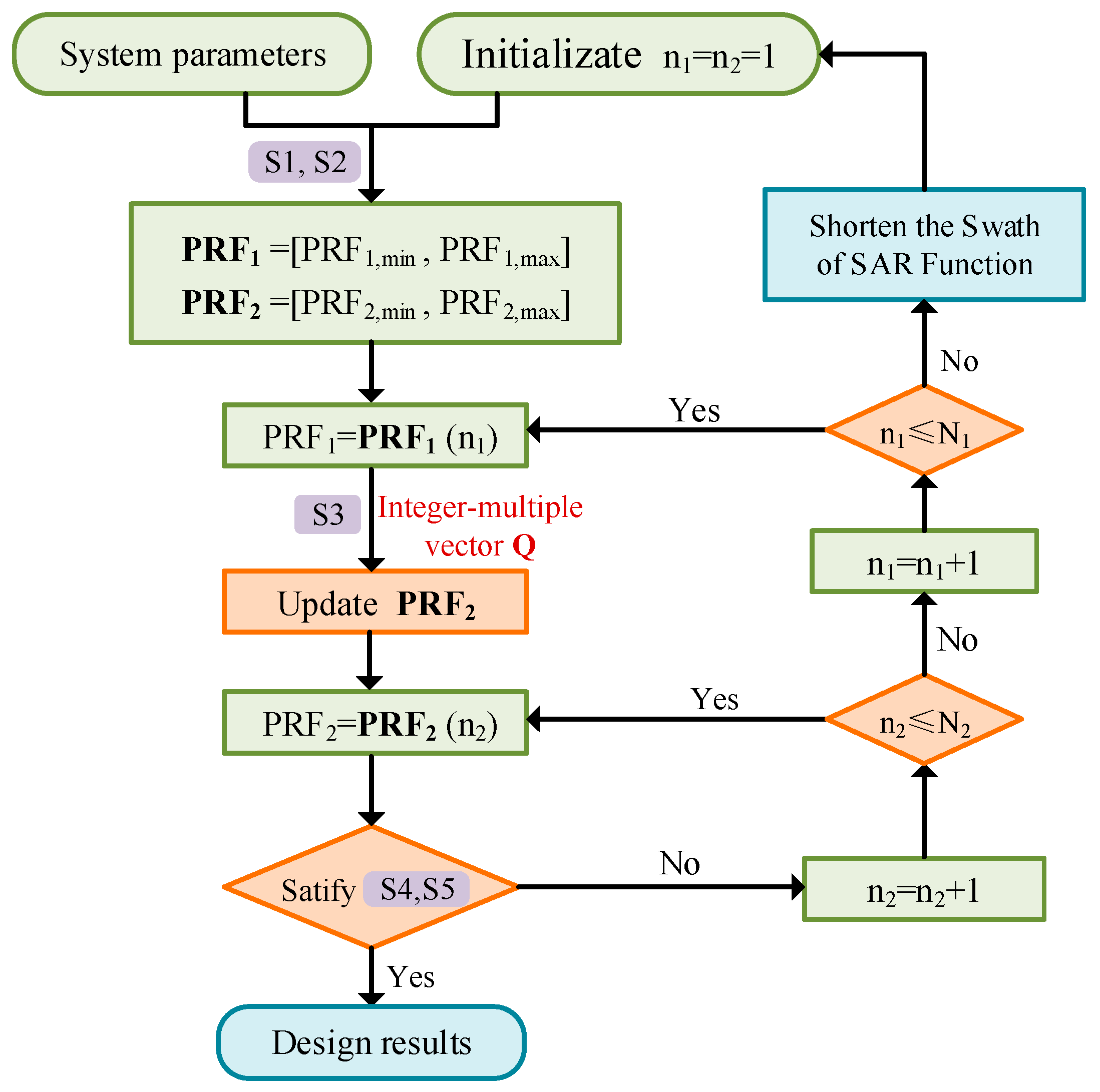

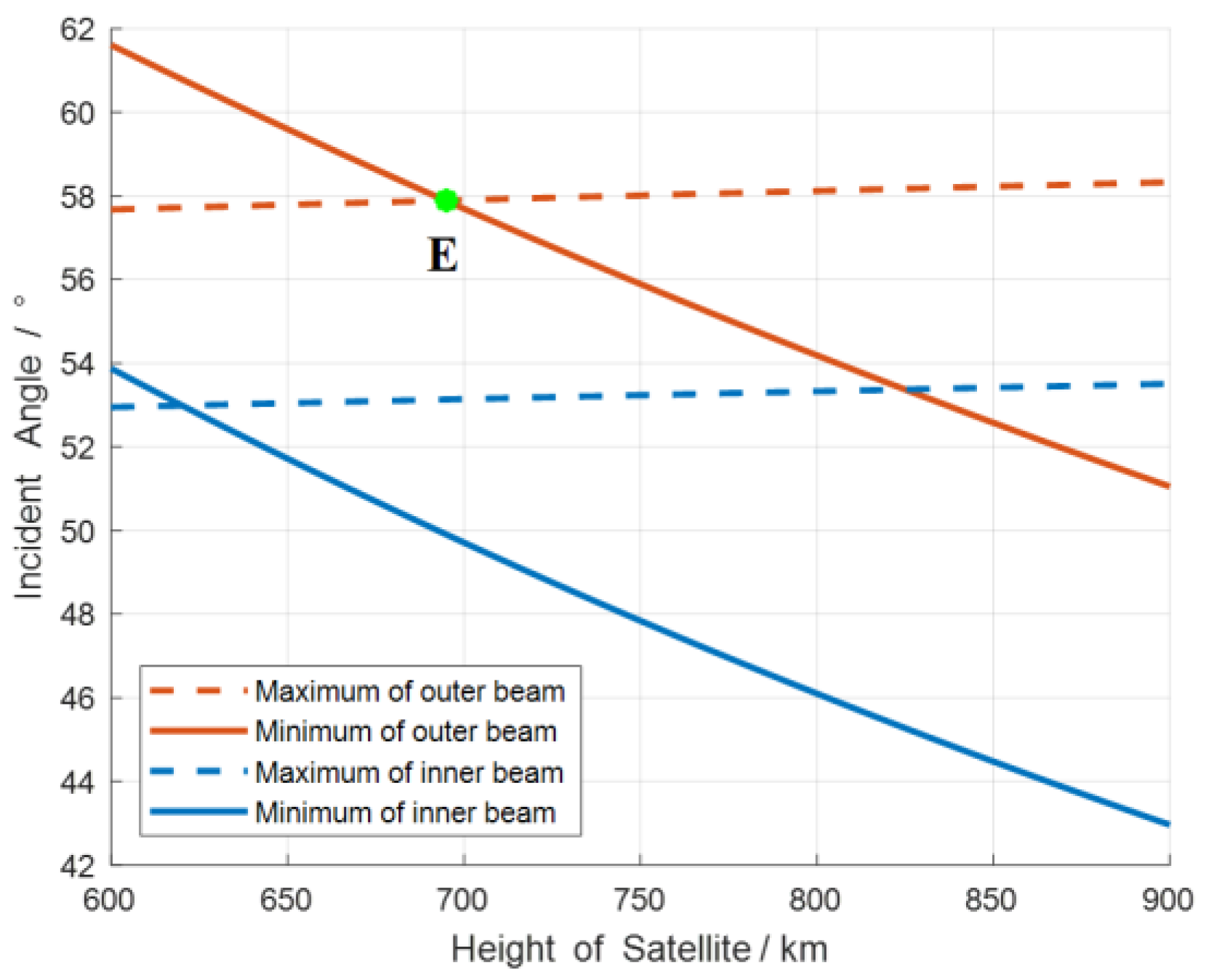

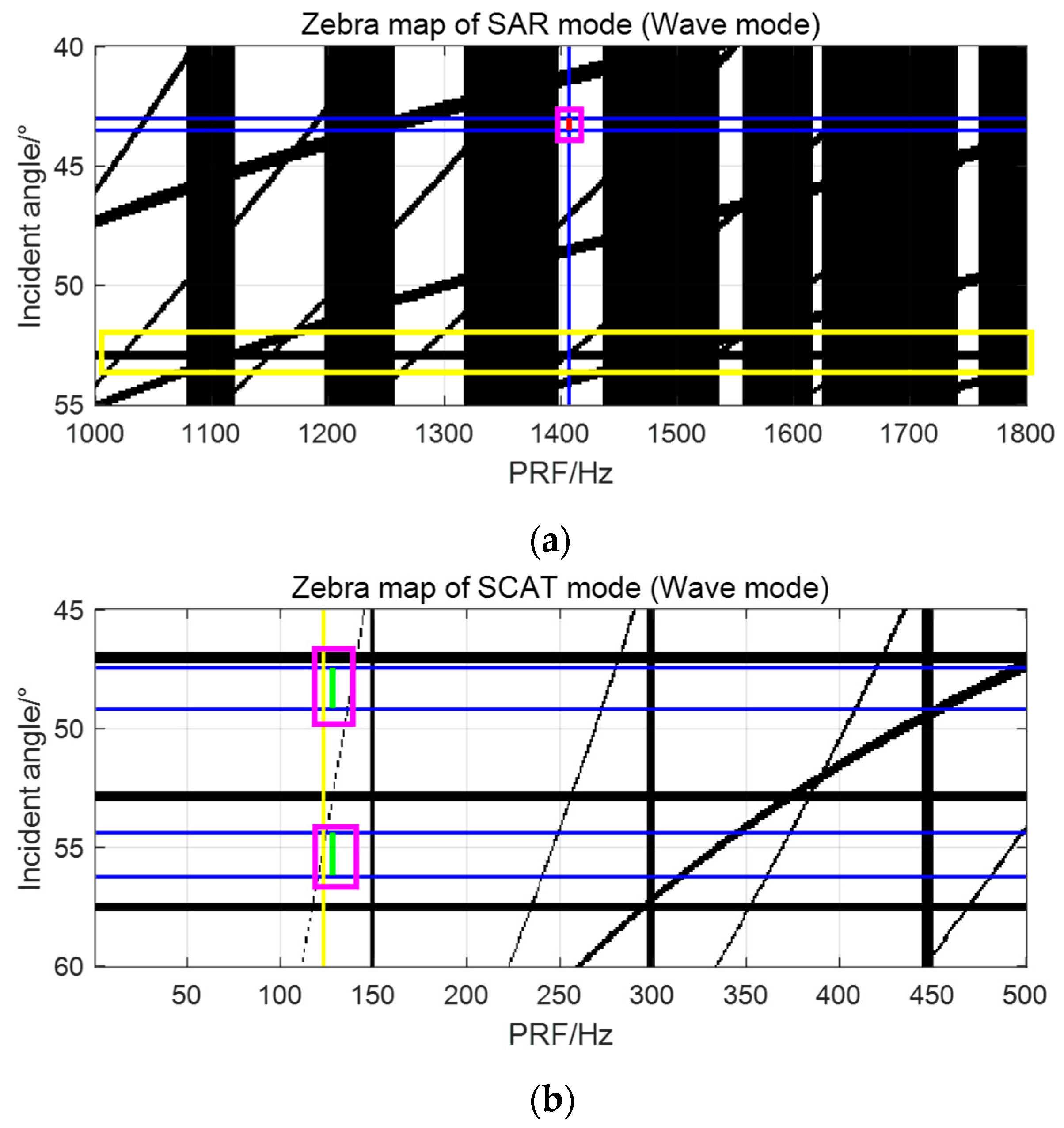
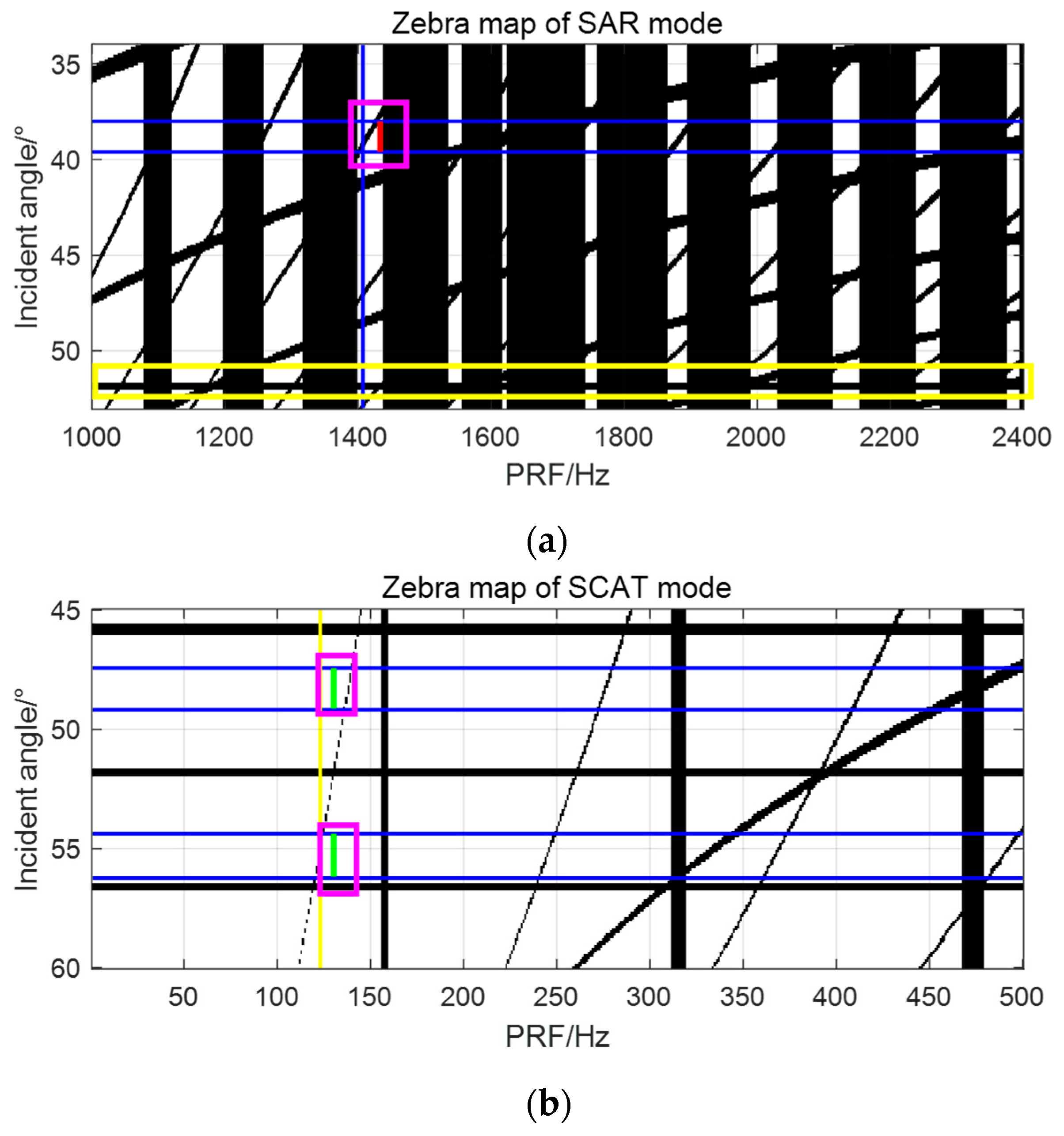

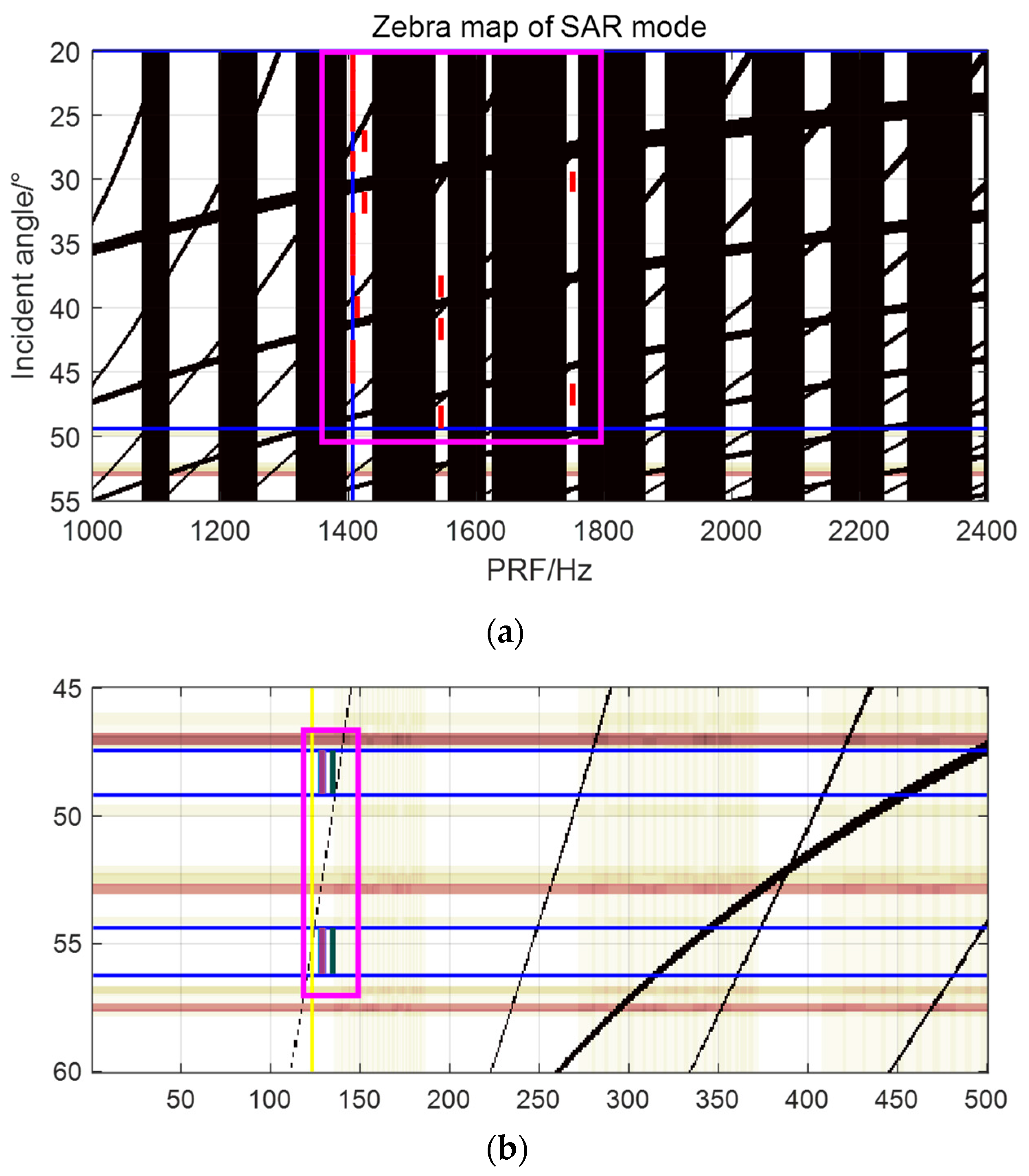
| Parameters | Values | ||
|---|---|---|---|
| SCAT Function | Swath (I/O) | ~1400 km/1800 km | |
| Range resolution (I/O) | <0.8/1.5 km | ||
| Azimuth resolution (I/O)) | <29/33 km | ||
| SAR Function | Local Mode Regional Mode Global Mode1 Global Mode2 (a × r) | Swath | ~20 km |
| ~100 km | |||
| ~500 km | |||
| ~5 km × 10 km | |||
| Resolution (a × r) | ~5 m × 5 m | ||
| ~30 m × 15 m | |||
| ~150 m × 60 m | |||
| ~10 m × 10 m | |||
| Parameters | Values | Parameters | Values | ||
|---|---|---|---|---|---|
| Common parameters | Height of Satellite | 769 km | Pulse width | 20 μs | |
| Azimuth antenna size | 10 m | Range antenna size | 0.82 m | ||
| SCAT Function | Carrier frequency | 13.4 GHz | Bandwidth | 0.5 MHz | |
| Peak power | 60 W | Incident angle (I/O) | 48.3/55.3° | ||
| PRF | 127.9–134.7 Hz | Rotation rate | 192.65°/s | ||
| Range footprint (I/O) | 39.7/52.3 km | Azimuth footprint (I/O) | 26.3/29.6 km | ||
| Swath (I/O) | 1490/1857 km | Resolution (a × r) | 12.5 × 12.5 km | ||
| SNR (I/O) | 6.7/9.2 dB | RASR | <−20 dB | ||
| SAR Function | Carrier frequency | 13.19 GHz | Bandwidth | 90 MHz | |
| Peak power | 5000 W | PRF | 1407–1751 Hz | ||
| SNR | 5.04–8.37 dB | AASR | <−18 dB | ||
| RASR | <−20 dB | ||||
| Local Mode Regional Mode Global Mode1 Global Mode2 | Incidence Angle | 20–48° (optional) | Swath | 21.8–38.1 km | |
| 36–42° (cover) | 120 km | ||||
| 20–48° (cover) | 502.7 km | ||||
| 43° | 10 km | ||||
| Resolution (a × r) | 5 × 5 m | ||||
| 30 × 10 m | |||||
| 90 × 30 m | |||||
| 5 × 5 m | |||||
Disclaimer/Publisher’s Note: The statements, opinions and data contained in all publications are solely those of the individual author(s) and contributor(s) and not of MDPI and/or the editor(s). MDPI and/or the editor(s) disclaim responsibility for any injury to people or property resulting from any ideas, methods, instructions or products referred to in the content. |
© 2024 by the authors. Licensee MDPI, Basel, Switzerland. This article is an open access article distributed under the terms and conditions of the Creative Commons Attribution (CC BY) license (https://creativecommons.org/licenses/by/4.0/).
Share and Cite
Li, H.; Liu, W.; Sun, G.; Chen, C.; Xing, M.; Zhang, Z.; Zhang, J. Concept of Spaceborne Ocean Microwave Dual-Function Integrated Sensor for Wind and Wave Measurement. Remote Sens. 2024, 16, 1472. https://doi.org/10.3390/rs16081472
Li H, Liu W, Sun G, Chen C, Xing M, Zhang Z, Zhang J. Concept of Spaceborne Ocean Microwave Dual-Function Integrated Sensor for Wind and Wave Measurement. Remote Sensing. 2024; 16(8):1472. https://doi.org/10.3390/rs16081472
Chicago/Turabian StyleLi, Hang, Wenkang Liu, Guangcai Sun, Changhong Chen, Mengdao Xing, Zhenhua Zhang, and Jie Zhang. 2024. "Concept of Spaceborne Ocean Microwave Dual-Function Integrated Sensor for Wind and Wave Measurement" Remote Sensing 16, no. 8: 1472. https://doi.org/10.3390/rs16081472






